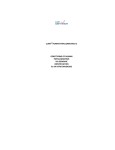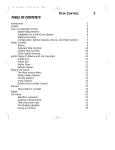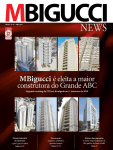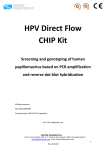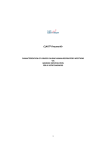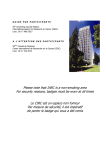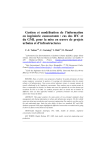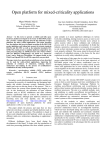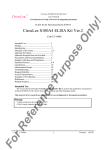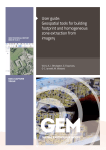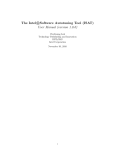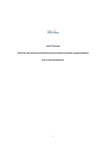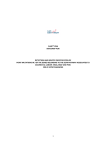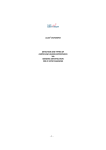Download User manual HPV4
Transcript
CLART® Human Papillomavirus 4 GENOTYPING OF HUMAN PAPILLOMAVIRUS VIA GENOMIC IDENTIFICATION for IN VITRO DIAGNOSIS CLART HPV4 CLART® HUMAN PAPILLOMAVIRUS 4 or CLART® HPV4 is under protection of 2 patent families corresponding to International PCT Patent Applications WO2007017699 and WO2011116797, which comprise national and regional members in different territories, including granted patents in Spain, Germany, Denmark, France, Italy, Sweden, Russia, Mexico, China and Israel, and patent applications under prosecution in Brazil and Canada. CLART®, CLART-Strip®, CAR®, SAICLART® and AUTOCLART® are registered Trademarks of GENOMICA. GENOMICA, S.A.U. Parque Empresarial Alvento, Edificio B Calle Vía de los Poblados, 1 – 1ª planta 28033 Madrid, Spain www.genomica.com Version 3 June 2015 CONTENTS: 1. GLOSSARY OF TERMS 2. DESCRIPTION 3. KIT COMPONENTS AND CONSERVATION 3.1. amplification reagents 3.2. Visualization reagents 3.3. Other components 4. ADDITIONAL MATERIAL 4.1. Reagents and material 4.2. Equipment 5. HANDLING PROCEEDINGS AND RECOMMENDATIONS 5.1. General recommendations 5.2. Visualization precautions 6. TAKING SAMPLES 6.1. Swabs 6.2. Cell suspensions 7. WORKING PROTOCOL 7.1. Sample processing without any need of DNA extraction 7.2. Amplification reaction 7.3. Visualization of amplified product on CLART-Strip® (CS) 7.3.1. Manual visualization 7.3.2. autoclart® visualization 8. RESULTS READING 9. RESULTS INTERPRETATION 10. TECHNICAL AND WORKING SPECIFICATIONS 11. REFERENCES 12. TABLES 13. BIBLIOGRAPHY 1. GLOSSARY OF TERMS Please, check handling instructions Expiry date In vitro diagnostic device Batch 25ºC Store at room temperature 20ºC 8ºC Store between 4 ºC and 8 ºC 4ºC -18ºC Store between –30 ºC and –18 ºC - 30ºC 4 2. DESCRIPTION Based on the amplification of specific fragments of the viral genome and their hybridization with specific probes for each HPV type, the CLART® Human Papillomavirus 4 kit is able to detect infections and co-infections of up to 35 HPV genotypes in only one tube. This approach presents a number of advantages: Its high sensibility allows detection of the minimal amounts of viral DNA without need of a complex extraction. Its high specificity allows detection of specific HPV genotypes by recognising a highly conserved sequence of the viral genome. The test can be easily performed in hospital laboratories. Its speed; results will be available within 6 hours. CLART® Human Papillomavirus 4 Kit detects different HPV subtypes (6, 11, 16, 18, 26, 31, 33, 35, 39, 40, 42, 43, 44, 45, 51, 52, 53, 54, 56, 58, 59, 61, 62, 66, 68a and b, 70, 71, 72, 73, 81, 82, 83, 84, 85 and 89) of the most clinically relevant HPV types in a wide range of samples (swabs, and cell suspensions). Detection of the different HPV genotypes is achieved by PCR amplification of a 450 bp fragment within the highly conserved L1 region of the virus. This highly conserved sequence presents slight variations among each individual HPV type that allows its genomic identification by recognition of the viral DNA by specific probes. This slight variation guarantees the detection specificity. The detection of the product amplified by PCR is carried out by means of a low-density microarray platform: CLART® (Clinical Arrays Technology). The platform is based on a very simple principle, but at the same time cost effective. It consists of a microarray printed at the bottom of a microtiter plate well, which simplifies the entire hybridization and visualization process when compared to classic microarray systems. Figure 1 displays a CLART-Strip® or CS of 8 wells. Figure 1. CLART-Strip® (CS) platform in the form of an 8-well strip. 5 CLART® Human Papillomavirus 4 detection system is based on the precipitation of an insoluble product in those microarray areas in which hybridization of amplified products with specific probes takes place. During PCR, amplified products are labelled with biotin. After amplification, these products are hybridized with their respective specific complementary probes that are immobilized in specific and well-known microarray areas. Afterwards they are incubated with a streptavidine-peroxidase conjugate. The conjugate is bound through streptavidine with the biotin present in the amplified products (which are bound to their specific probes) and the peroxidase activity prompts the appearance of a non-soluble product in the presence of the o-dianisidine substrate, which precipitates on the microarray areas where hybridization occurs (Figure 2). 6 Labelled products Probes on the array Biotin Hybridization Incubation with conjugate Conjugate Specific precipitation Development reaction Figure 2: Diagram of the visualization method. Probes, immobilized on the surface, capture their complementary biotin-labelled amplified products. With the help of biotin, they bind to the conjugate, in this case streptavidine-HRP (HorseRadish Peroxidase). The o-dianisidine substrate, by the action of the HRP, produces a precipitate on the area where hybridization occurs. 7 3. KIT COMPONENTS AND CONSERVATION CLART® Human Papillomavirus 4 Kit contains sufficient reagents for analysis of 16, 48 or 96 clinical samples. These reagents are provided in two different boxes, depending on the temperature at which they should be kept. All the reagents provided are stable under the appropriate conditions until the indicated expiration date. 3.1. Amplification reagents. They are shipped and should be stored at -20ºC. Amplification tubes contain 45 µl of reaction mix. They are sent ready to use and must be stored at -20ºC. Only the required number should be thawed on ice at any given time while the remainders should be kept at –20ºC. Note: the kit includes an adhesive temperature indicator strip. If a red colour appears in the viewing window of this temperature indicator strip, the cold chain may have been broken and the kit should not be used. 3.2. Visualization reagents. They are shipped and should be stored at 4ºC. WARNING: Once received, the CLART-Strip® (CS) should be stored at room temperature. CLART-Strip® (CS) strips (including all specific probes). They are provided in a sealed thermal envelope. Store it closed at room temperature (25oC max.), protected from direct light. SH (Hybridization Solution). Store at 4ºC. DC (Conjugate Diluent). Store at 4ºC. CJ (Conjugate). Store at 4ºC. Centrifuge once before use. RE (Development Solution). Store at 4ºC and protected from light. TL (Wash Buffer). Store at 4ºC. Adaptor and lid for 8-well strips. 3.3. Other components. The following components are required for the capture and subsequent image processing: CAR® (CLINICAL ARRAY READER): which allows the reading and automatic interpretation up to 12 CS, that means, a total amount of 96 samples. This platform is manufactured exclusively for GENOMICA kits use only. SAICLART®: software developed by GENOMICA for image processing. CLART® HPV4 Software: It is specific for CLART® HPV4 designed and validated by GENOMICA. Installed and ready to use. 8 Figure 3. CAR® (CLINICAL ARRAY READER) 4. ADDITIONAL MATERIAL 4.1. Reagents and material. Distilled water Disposable gloves Positive displacement or filtered pipette tips Bowl of chipped ice 1.5 mL autoclaved Eppendorf type tubes. 1.5 mL tube grids. 0.5 mL/0.2 mL tube holder. Saline solution 0.9% NaCl 4.2. Equipment. autoclart® (Figure 4) The following equipment is needed for the automatic visualization phase. It enables the automatic visualization of up to 12 CS that means a total amount of 96 samples. Figure 4. autoclart® 9 Microcentrifuge. Thermocycler. Laminar flow chamber for the extraction laboratory. Three adjustable micropipettes (1-20 µl, 20-200 µl and 200-1000 µl) for use in the extraction laboratory. ( Pre-PCR lab) Three adjustable micropipettes (1-20 µl, 20-200 µl and 200-1000 µl) for use in the visualisation laboratory. ( Post-PCR lab) Thermoblock compatible with 96-well plates and adjustable shaking at 25°C, 30°C and 65°C. Vortex Vacuum system (desirable) 5. HANDLING PROCEEDINGS AND RECOMMENDATIONS Very important: Read this section carefully before beginning any work in order to prevent potential contamination. 5.1. General recommendations. 1. This assay should be performed in two physically separated areas, in order to avoid sample contamination with the previously amplified product. Separate working materials should be available in each area (pipettes, tips, tubes, grids, gloves, etc.) which should never be used outside these areas. 1. Pre-PCR area: Addition of the extracted material to the amplification tubes are performed in this area. Sample manipulation must be carried out within a biosafety cabinet (BSC). 2. Post-PCR area: Amplification and visualization of the amplified product are carried out in this area. The material of this area should never come into contact with the material of the extraction area. Avoid entering the pre-PCR area after having worked in the visualization area. 2. Always use gloves. It is recommended to change gloves quite frequently, and it is mandatory to change gloves before start working in each of the aforementioned areas. New gloves must always be used when DNA is added to the amplification tubes. 3. Clean working areas (laboratory cabinets, hoods, grids, pipettes) thoroughly with a 10% diluted bleach solution after every sample batch processing; it is mandatory to disinfect all working areas in case of contamination. For thermocyclers and thermomixers, it is advised to clean them before and after used, in these same conditions. 4. Always use filter tips and positive displacement pipettes to avoid contamination due to micropipettes. Different sets of pipettes should be used in each area. 5. Use disposable and autoclaved laboratory material. 6. Never mix reagents from two different vials, even if they belong to the same lot. 10 7. Close reagent tubes immediately after use in order to avoid contamination. 8. Discard the micropipette tip after pipetting. 9. GENOMICA is not responsible for the results obtained with the kit if other samples different to the ones indicated are used. 5.2. Precautions for the addition of material to the amplification tube 1. Always wear gloves. 2. Clean working surfaces of cabinets with a 10% diluted bleach solution. 3. Turn on the laminar flow and UV light at least 20 minutes before extraction. Turn off the UV light when it is working inside the cabinet. 4. The preparation of the samples before extraction must be made inside the cabinet. 5.3 Precautions for visualization 1. Avoid the pipette tip or the vacuum system touching the bottom of the well, since this could damage the probes printed at the well’s bottom. 2. It is recommended to add all solutions to the wall of the CS (CLART-Strip®) well; never directly at the bottom. 3. It is convenient not to add the SH solution until the denatured products of PCR are ready. 4. The array must not remain dry. 5. Following incubation with the CJ solution, it is very important to wash the microarray thoroughly in order to avoid any residues that could react with the RE solution, resulting in a non-specific precipitation that could lead to false interpretations of the result. 6. Avoid foaming when adding any reagent. 7. When visualizing the image in the reader, ensure that position markers appear and that there are no bubbles, fibres or spots interfering with the reading. Otherwise, clean the outer face of the well with a cloth and alcohol. 6. TAKING SAMPLES 6.1. Swabs. Samples should be taken with a clean, dry, cotton or alginate swab large enough to obtain a good sized sample. Do not use devices that could cause any bleeding, as blood may interfere with the assay. Place the swab in its tube, which should not contain any kind of preservation medium. Maintain the swab at 4ºC if it is to be processed within seven days, or at –20ºC if processing is to occur later. 11 6.2. Cell suspensions. Cervicovaginal cytology tests (membrane-filtered monolayers [ThinPrep®, Cytyc]) are refered in this section. After taking the sample with a brush or spatula, resuspend the sample in a vial containing the transport medium by agitating the sampling device. Dispose of the sampling device and keep the sample at 4ºC until use. 7. WORKING PROTOCOL Samples can be tested without extraction. Nonetheless, some pre-treatment may be needed. Please, note the following protocols for the pre-treatment of the samples”. 7.1. Sample processing without any need of DNA extraction 7.1.1. Dried swab Add 1.5 ml of Saline solution. Vortex it properly and it will be ready for the amplification reaction. In case the sample was previously extracted, do not add saline solution again and please take 5µl of the remnant solution for the PCR. 7.1.2. Digene STM Add 200 µl of the sample to the 1.5 ml tube. Centrifuge at 4.000 rpm for 1 minute. Discard the supernatant. Add 1 ml saline solution, Vortex properly, centrifuge 1 minute at 4.000 rpm. Discard the supernatant. Add 1 ml saline solution, Vortex it properly, centrifuge at 4.000 rpm for 1 minute. Discard the supernatant Resuspend the pellet in 50 µl of DNAsa free water. 7.1.3. Celular suspensión, ThinPrep Take 400 µl of celular suspensión to a 1.5ml tube. Centrifuge 1 minute at 13.000rpm. Discard the supernatant. Resuspend the pellet in 400 µl of Saline solution. Centrifuge 1 minute at 13.000rpm. Discard the supernatant. Resuspend the pellet in 25 µl of DNAsa free water. 7.2. Amplification reaction. Amplification-specific recommendations: Work in the pre-PCR area, always using a cabinet and following the recommendations mentioned in section 5.1. Add the processed sample ( see point 7.1) , directly to the amplification tube. Always work under the hood and following the instructions described at the point 5.1. During all the protocol keep the tubes separated and cool. 12 1. Thaw one reaction tube for each sample and keep them on ice. Do not use temperatures above 37ºC for thawing. 2. Centrifuge the reaction tubes in a microcentrifuge so all the liquid goes to the bottom (if no adapters are available to hold the reaction tubes, it can be placed in larger tubes with their caps removed). 3. Add 5 µl of proccesed sample to the reaction tubes and resuspend several times with a micropipette. Leave the tubes on ice. 4. Program the thermocycler as follows: 1 cycle 98ºC 5 min 98ºC 15 sec 55ºC 15 sec 45 cycle s 72ºC 30 sec 72ºC 1 min 1 cycle Hold at 4ºC until tube collection (optional) 5. Start the program and place the reaction tubes in the Thermocycler when the block is above 90ºC. The amplification process takes about 2 hours, although this can vary depending on the Thermocycler used. This technique has been validated for conventional thermocycler , not fast-ramp thermocycler 7.3. Visualization of amplified products on CLART-Strip® (CS) Specific recommendations before starting the visualization process: THE PROTOCOL DESCRIBED BELOW SHOULD ALWAYS BE PERFORMED IN THE POSTPCR AREA. DO NOT TAKE THE AMPLIFIED PRODUCT IN THE PRE-PCR AREA. 1. Turn on the CAR® (CLINICAL ARRAY READER) before starting the whole procedure. The self-calibration of the equipment takes a few minutes, and it is also necessary to introduce the name of the samples in the program before the reading. 2. Make sure that, before the hybridization begins, the thermomixer temperature has reached the 65ºC for at least 1 hour. 3. Warm up the SH in the thermomixer. 4. Prepare fresh TL before each assay; do not reuse previously prepared solutions or residues. 5. Use different filtered tips for each well and change it every time a reagent is added. 13 6. In case of using vacuum pumps equipped with 8-tip comb for aspirating solutions, discard the combs after each use or decontaminate them with a 10% diluted bleach solution after every assay. Make sure the pump aspirates properly and does not leave traces at the bottom of the well. 7. Aspirate the different solutions completely without touching the array. 7.3.1. Manual visualization 1. Denaturation: Place the amplification tubes in the thermocycler when this has reached 95ºC and incubate the tubes for 10 min. Not to exceed 10 min time of denaturation to prevent the tubes are opened and contamination may occur. Remove the tubes from the 95ºC incubation and place them immediately on ice. 2. Prepare TL diluted Solution: For 8 wells (one Cs) add as follows: 1 ml of TL solution + 9 ml of distilled water. This will make up 10 ml of diluted TL solution necessary for one strip. 3. Pre-washing of CS: Before starting the assay, it is necessary to pre-wash the CS by adding 200 µl of TL diluted solution per well. After the addition, mix the TL diluted solution 10 to 15 times with the pipette avoiding touching the surface of the array. Aspirate the TL diluted solution with the pump, making sure that the well remains completely clean with no remaining liquid. Add the buffer straight away as follows: 4. Hybridization: Hybridization solution (SH) must be heated at 50ºC in order to dissolve crystallized salts. Add 100 µl of SH buffer (avoiding foam formation) + 10 µl of denatured product to each well. Mix well with the pipette avoiding touching the array and incubate the strip, covered with the transparent plastic lid, in the thermomixer for 30 minutes at 65 oC, shaking at 550 rpm. After the incubation, take the CS out of the thermoshaker and remove the SH buffer with the pump. (Set the Thermomixer at 30oC and shaking at 550 rpm for step 6. Remove the lid to speed up the cooling). 5. Double washing: use different tips for each well in both washes. Add 200 µl of diluted TL buffer and mix 10 to 15 times with the pipette. Remove the TL diluted solution with the pump. Repeat this wash once and leave the CS with 200 µl of TL buffer until the Thermomixer has reached 30oC. 6. Blocking and adding conjugate: Prepare the diluted CJ solution 15 minutes before hybridization time is over and keep it on ice until its use. It is recommended to spin the CJ buffer for 10 seconds before using. Prepare the diluted CJ buffer: For one strip (8 wells) add as follows: 1 ml of DC buffer 9 µl of CJ buffer. Vortex the diluted CJ solution briefly before use. 14 Remove the diluted TL buffer without drying out the array and add 100 µl of diluted CJ buffer to each well. Incubate in the Thermomixer at 30oC, 550 rpm, for 15 minutes exactly. After this incubation, take the Cs and remove the diluted CJ buffer immediately with the pump (see figure 4). (Set the Thermomixer at 25oC and no shaking for step 8. Remove the lid to speed up the cooling). 7. Triple Washing: Add straight away 200 µl of TL diluted solution per well. Mix well 10 to 15 times with the pipette and remove the diluted TL buffer with the pump without drying out the array. Repeat this wash twice and leave the CS with 200 µl of TL buffer at RT for 5-10 minutes or until the Thermomixer has reached 25oC. It is very important that the diluted CJ buffer is completely washed off. Any remaining buffer could react with the RE buffer producing an unspecific signal. 8. Developing with RE buffer: Remove the diluted TL buffer without drying out the array and add 100 µl of RE buffer per well. Incubate in the Thermomixer at 25oC for 10 minutes without agitation. Attention! It is very important to use the Thermomixer without agitation in this step. 9. After 10 minutes, remove the RE buffer with the pump. The array must be dry at this time. 10. CAR® (CLINICAL ARRAY READER): In order to analyse the samples, place the plate normally on the tray and the CAR® will take and analyse the arrays automatically. 7.3.2. autoclart® visualization 1. Denaturation: Place the amplification tubes in the thermocycler when this has reached 95ºC and incubate the tubes for 10 min. Not to exceed 10 min time of denaturation to prevent the tubes are opened and contamination may occur. Remove the tubes from the 95ºC incubation and place them immediately on ice. 2. Switch on the autoclart® unit and follow the instructions described on the screen: 3. Closet the door and press the knob. 4. Select Run at the main menu. 5. Select the assay HPV4 test among those listed. 6. Select the well of the strip where run should start: A1 or E1 in case the first 4 wells have been already processed. 7. Select the amount of samples to be processed. The autoclart®allows to process from 4 up to 96 samples per run. In any case, samples should be always multiples of four. 15 8. Confirm the number of samples and start up well (A1 or E1) are correct. 9. Place the tips rack (full) on its position. 10. Check that both, tip waste and liquid waste containers are empty. 11. Fill the bottle with 250 ml distilled water. 12. Add each reagent to its specific container. autoclart® calculates the specific volumes required according to the amount of samples indicated: - TL (Washing buffer). Volume showed in the display indicates the diluted washing buffer required. In order to prepare the diluted washing buffer please dilute the TL reagent provided 1:10 into distilled water. - SH (Hybridization solution). It is provided ready to use. Add the specified volume in the container once tempered. - CJ (Conjugate). It’s recommended to shortly spin the CJ before use. Display shows final volume of diluted CJ, meaning that each mL indicated on the display should be prepared as follows: 1 ml of DC (Conjugate Diluent) and 9 µl CJ reagent. Vortex the diluted solution in order to mix it properly up. - RE (Developer). Add the RE volume indicated on the display. 13. Close the door and press the knob. The device will start priming the system and cleaning the tips with water. Then it will perform the pre-washes of the CS and adding the hybridization solution. Once finished these steps, the device will beep as a signal for pipetting the samples on their specific CS. autoclart®t will automatically stop beeping as soon the user opens the door. 14. For adding the samples on the CSs, please remove the plate carefully from autoclart® unit and add 10µl of the denatured product respectively to each well. Mix it up carefully in order not to touch the array and place the microplate again on the autoclart®. Press the knob again to continue the visualization process. 15. Once finished the visualization process, the autoclart® unit will beep indicating the end of the run. Please remove the microplate carefully and proceed with the reading step on the CAR®. 16. CAR® (CLINICAL ARRAY READER): place the plate normally on the tray and the CAR® will take and analyze the arrays automatically. 8.RESULTS READING The processing of the obtained data in each analysis is completely automatic. The reading/analysis equipment will provide a report with the results. On the screen, a table with three columns will appear. The left column shows the HPV genotypes that can be detected, the central column will give either a positive or negative result for each genotype, and the right column will show if the amplification and DNA controls are fulfilled. 16 9. RESULTS INTERPRETATION One of the main drawbacks of genomic amplification is the utilization of poor quality DNA samples (too short DNA, degradation of the DNA, or loss of DNA during extraction) or the presence of DNA polymerase inhibitors (e.g., hemoglobin, remains of paraffin wax, salts etc.) in the samples to be analysed, thus interfering with the genomic amplification and resulting in false negatives. However, the CLART® Human Papillomavirus 4 eliminates false negatives using internal controls within the same tube where the sample is analysed, and that are amplified at the same time as the viral DNA. Every reaction (amplification) tube of the kit contains the following primers: A pair of primers that amplify a fragment of the human gene CFTR (genomic DNA or DNA from the patient). It is used as genomic DNA control. A pair of primers that amplify a modified plasmid that is included in the tube and which is used as a amplification reaction control. HPV primers. The reaction tube has been designed in order to favour the amplification of the HPV against the other two controls. Among these two controls, the genomic DNA will amplify preferentially compared to the amplification reaction control. The reason for this design is: Genomic DNA control would only be essential for confirming a negative result, since it reports that DNA from the patient was present in the sample even if no HPVs were found. PCR control would only be essential if no amplification in the tube is found, because it will help to distinguish between an inhibited PCR and a sample where no DNA has been found. However, when HPVs are present in the sample, there is always a preference to amplify genotypes instead of amplifying the controls. Hence, under certain conditions (i.e. high copy numbers of a particular HPV genotype or several HPV genotypes present in one sample) internal controls may not appear (NO SIGNAL). Taking in mind these observations, we can consider the following result interpretations: It is considered as a VALID RESULT. POSITIVE FOR ANY GENOTYPE GENOMIC DNA CONTROL AMPLIFICATION CONTROL INTERPRETATION √ Positive for any genotype √ √ POSITIVE x. Negative for any genotype √ √ NEGATIVE Other VALID RESULTS: RESULT FOR ANY GENOTYPE GENOMIC DNA CONTROL AMPLIFICATION CONTROL INTERPRETATION VALID RESULT, 17 √ Positive √ √ Positive NO SIGAL X. Negative √ NO SIGNAL NO SIGNAL NO SIGNAL POSITIVE POSITIVE NEGATIVE Even if the amplification control reports NO SIGNAL. This is due to the competition during the amplification between the three types of DNA. Even if the two controls appear as NO SIGNAL. This is due to a high number of copies of one virus genotype or high number of HPVvirus present in the sample. even if the PCR control does not appear, due to a high concentration of genomic DNA. It is considered as INVALID RESULT RESULT FOR ANY GENOTYPE √ Positive √ Positive G. DNA CONTROL NO SIGNAL NO SIGNAL A.CONTROL √ NO SIGNAL INTERPRETATION NO DNA PCR INHIBITED INVALID RESULT SOLUTION This is due to the absence of DNA in the sample The solution in these cases is to repeat the technique from the extraction or to take a new sample from the patient This is due to the presence of some substances that can inhibit the DNA polymerase. The solution is to check for the presence of these substances, although it is preferable to repeat the extraction, or to take a new sample. An UNCERTAIN RESULT may appear due to one of these possibilities: If the three copies of the same probe are very different among each other. If there is a co-infection and one of the detected viruses is in the threshold between positive and negative. 10. TECHNICAL AND WORKING SPECIFICATIONS KNOWN SOURCES OF INTERFERENCE Certain substances can interfere with the CLART Human Papillomavirus 4 kit. These are mainly substances that inhibit DNA polymerase, and therefore the amplification reaction. For example: 18 1. Hemoglobin. . An inhibition could be the result of an excess of hemoglobin or organic detritus in the amplification tubes due to removal the purification phase. 2. Acetic acid and iodine. If a sample for analysis is taken after a colposcopy, contamination of the sample with acetic acid or iodine is possible. Since both compounds can inhibit PCR, we strongly recommend taking the samples before performing the colposcopy. 3. Use of inadequate samples. The use of any sample types other than those indicated in this manual, or the incorrect taking of samples, could lead to non-conclusive results. For example, if a sampling swab is placed in an alternative medium, PCR might be inhibited, or if samples are left in formalin for too long, the DNA may degrade. 4. Inadequate conservation of samples. If the samples are held under conditions that lead to the degradation of their DNA, the results may be unreliable. TECHNICAL SPECIFICATIONS 1. Analytical parameters: Analytical sensitivity. The analytical sensitivity was determined by specific amplification of the different-HPV-genotypes L1 region cloned in recombinant plasmids. (Columns 102 copies and 10 copies). Sensitivity of the HPV types in column 50 copies were also determined from samples from the 2013 WHO HPV LabNet Proficiency Study of HPV DNA Typing. HPV GENOTYPE 6 11 16 18 26 31 33 35 39 45 51 52 53 56 58 59 66 68a 68b 82 2 10 copies 100% 100% 100% 100% 100% 100% 100% 100% 100% 100% 100% 100% 100% 50 copies*(2013 WHO HPV 100% 100% 100% 100% 100% 100% 100% 100% 100% 100% 100% 100% 100% 100% 100% 100% 100% 10 copies 100% 80% 80% 80% 100% 100% 80% 60% 80% 80% 80% 100% 100% 80% 60% 80% 100% 80% 100% N: 110 Table 1. Analytical sensitivity of CLART® HPV4 kit 19 Due to the clinical significance of HPV types 16 & 18, we have included the sensitivity data from these types from the 2013 WHO HPV LabNet Proficiency Study of HPV DNA Typing Table 1 also shows sensibility of other types included in the panel of the study. This program compares and evaluates the different methodologies of the HPV detection used in the HPV vaccination programs. A data set was considered proficient when it was detecting at least 50 international units (genome equivalents) of HPV 16 and HPV 18, fact achieved within CLART® Human Papillomavirus 4. 2. Diagnostic parameters. In order to determine the diagnostic parameters of the kit CLART® Human Papillomavirus 4, comparative studies against the HPV2.version of the kit were performed. This comparison was performed in collaboration with two Spanish hospitals and a Portuguese one. Microbiology Service of the University Hospital Germans Trías i Pujol of Badalona. Virology Unit of University Hospital Virgen de la Arrixaca, Murcia. Pathological Anatomy Service of University Hospital San Carlos. Pathological Anatomy Service of University Hospital Marqués de Valdecilla. A total amount of 419 samples were performed, including 44 dry swabs, 101 from Digene STM and 232 ThinPrep® liquid-based cytology. The following table illustrates the diagnostic sensitivity and specificity data for HPV types detected in the kit CLART® Human Papillomavirus 4 from direct sample without need of DNA extraction : HPV type Type 6 Type 11 Type 16 Type 18 Type 31 Type 33 Type 35 Type 39 Type 40 Type 42 Type 43 Type 44 Type 45 Type 51 Type 52 Type 53 Type 54 Sensitivity 100,0 83,3 100,0 100,0 93,8 100,0 100,0 100,0 100,0 100,0 100,0 100,0 100,0 100,0 92,6 97,1 100,0 Specificity 100,0 100,0 100,0 100,0 100,0 100,0 100,0 100,0 100,0 100,0 100,0 99,5 100,0 100,0 100,0 100,0 100,0 HPV type Type 56 Type 58 Type 59 Type 61 Type 62 Type 66 Type 68 Type 70 Type 71 Type 72 Type 73 Type 81 Type 82 Type 83 Type 84 Type 89 Sensitivity 100,0 93,3 95,0 100,0 87,0 100,0 100,0 81,8 100,0 100,0 100,0 100,0 90,0 100,0 100,0 100,0 Specificity 99,7 100,0 99,7 100,0 100,0 99,8 99,8 100,0 100,0 100,0 100,0 100,0 100,0 100,0 100,0 99,5 Table 2. Diagnostic parameters of CLART® HPV 4. 20 11. REFERENCES Bosch, F.X., Lorincz, A., Muñoz, N., Maijer, C.J.L.M. and Shah K.V.: “The causal relation between human papillomavirus and cervical cancer”. J. Clin. Pathl. 55, 244-265 (2002). Calleja-Macías, I.E., Villa, L.L., Prado, J.C. et al. "Wordwide genomic diversity of the high-risk human papillomavirus types 31, 35, 52, 58, for close relatives of human papilloma virus type 16”. Journal of Virology. 79, 13630-13640 (2005). Chranioti A., Spathis A., Aga E., Merustoudis C. Pappas A., Panayiotides I. and Karakitsos P. “Comparison of two commercially available methods for HPV Genotyping: CLART HPV2 and Linear Arrays HPV Genotyping Test”. Analytical and Quantitative Cytopathology and Histopathology. Volumen 34, number 5, October 2012. De Villiers, E.M.: “Heterogeneity of the human papillomavirus group”. J. Virol. 63, 4898-4903 (1989). Dunne, E.F., Unger E.R., Sternberg m., McQuillan G., Swan D.C., Patel S.S., Markowitz L.E.: “Prevalence of VPH infection among females in the United States”. JAMA, February 28, 2007Vol 297, nº 8. Flavio, L.: “VPH genotyping: are different hybridization methods comparable in detecting high risk infections?” 23rd International papillomavirus conference and clinical workshop. September 2006. Praga. Garbugliaa A. R., Piselli P., Lapaa D., Sias C., Del Nonnoc F., Baiocchinic A., Cimagliab C., Agrestab A. and Capobianchia M. R. “Frequency and multiplicity of human papillomavirus infection in HIV-1 positive women in Italy”. Journal of Clinical Virology. JCV-2429 (2012). Goldman B., Rebolj M., Rygaard C., Preisler S., Ejegod DM, Lyngea E., and Jesper Bonde. “Patterns of cervical coinfection with multiple human papilloma virus types in a screening population in Denmark”. Vaccine 2013 Mar 15;31 (12): 1604-9. Kjær S.K., Frederiksen K., Munk C., Iftner T. Long-term Absolute Risk of Cervical Intraepithelial Neoplasia Grade 3 or Worse Following Human Papillomavirus Infection: Role of Persistence. J Natl Cancer Inst. 2010 Sep 14. Muñoz, N., Bosch, X., Sanjosé, S., Herrero, R., Castellsagué, X., Shah, K.V., Snijders, P.J.F. y Meijer, C.J.L.M. “Epidemiologic classification of human papillomavirus types associated with cervical cancer”. N. Engl. J. Med. 348, 518-527 (2003). Pista, A., Freire de Oliveira C., Lopes C., and Cunha M. J., on behalf of the CLEOPATRE Portugal Study Group. “Human Papillomavirus Type Distribution in Cervical Intraepithelial Neoplasia Grade 2/3 and Cervical Cancer in Portugal A CLEOPATRE II Study”. International Journal of Gynecological Cancer & Volume 23, Number 3, March 2013 Ronco G., P. Giorgi-Rossi, F. Carozzi, M. Confortini, P. Palma, A. Mistro, B. Ghiringhello, S. Girlando, A. Gillio-Tos, L. Marco, C. Naldoni, P. Pierotti, R. Rizzolo, P. Schincaglia, M.Zorzi, M. Zappa, N.Segnan, J. Cuzick. “Efficacy of human papillomavirus testing for the detection of invasive cervical cancers and cervical intraepithelial neoplasia: a randomised controlled trial”. Lancet Oncol. 2010 Mar;1 1(3):249-57. 21 Suarez Moya, A., Esquivias Gómez, J.I., Vidart Aragón, J.A. Picazo de la Garza, J.J.: “Detección y tipificación mediante biología molecular del virus del Papilloma humano en muestras genitales”. Rev. Esp. Quimioterap., Junio 2006; Vol. 19 (Nº2); 161-166. Verdasca, N.; A. Coelho; F. Ribeiro; A. Pista.: “Detection of VPH ADN from cervical samples in a group of portuguese women: comparison of two VPH genotyping assays”. 24th internacional papillomavirus conference and clinical workshop, Nov 3-9, 2007, Beijing, P.R.China." Verdasca, N., A. Coelho, F. Ribeira, A. Pista.: “Detection of VPH ADN from cervical samples in a group of portuguese women: comparison of two VPH genotyping assays”. 23rd International papillomavirus conference and clinical workshop. September 2006. Praga. 22 12. TABLE Oncogenic risk of the HPV types detectable with CLART® HPV4. TYPE PVH 6 ONCOGENIC RISK * TYPE ONCOGENIC RISK * Low Risk PVH 56 Hight Risk PVH 11 Low Risk PVH 58 Hight Risk PVH 16 Hight Risk PVH 59 Hight Risk PVH 18 Hight Risk PVH 61 Low Risk PVH 26 Problable Hight Risk PVH 31 Hight Risk PVH 62 Low Risk PVH 66 Hight Risk PVH 33 Hight Risk PVH 35 Hight Risk PVH 68 Hight Risk PVH 39 Hight Risk PVH 71 Low Risk PVH 40 Low Risk PVH 72 Low Risk PVH 42 Low Risk PVH 43 Low Risk PVH 73 Probable Hight Risk PVH 81 Low Risk PVH 44 Low Risk PVH 82 Probable Hight Risk PVH 45 Hight Risk PVH 83 Low Risk PVH 51 Hight Risk PVH 84 Low Risk PVH 52 Hight Risk PVH 85 Low Risk PVH 53 Probable Hight Risk PVH 89 Low Risk PVH 70 Low Risk PVH 54 Low Risk *According to: Bouvar d V, Baan R, Straif K, Grosse Y, Secretan B, El Ghissassi F et al. A review of human carcinogens -Part B: biological agents. Lancet Oncol 2009:10( 4):321 322 23























